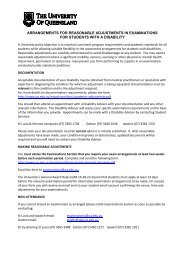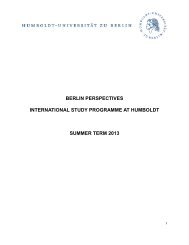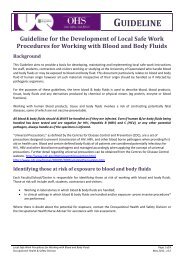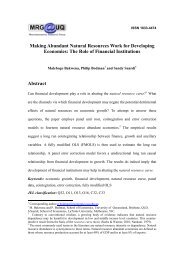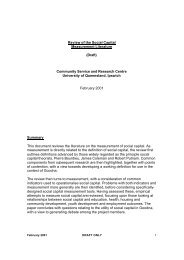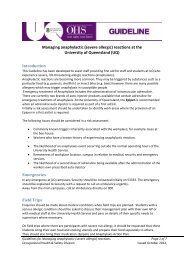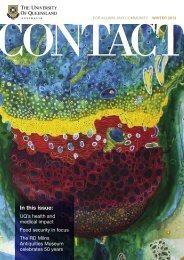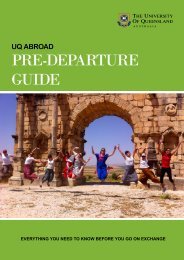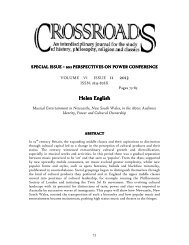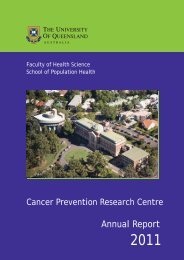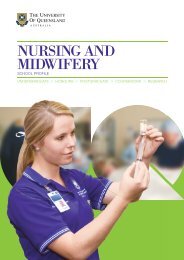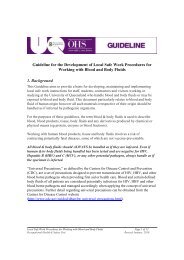Mechanical disruption of seagrass in the digestive tract of the dugong
Mechanical disruption of seagrass in the digestive tract of the dugong
Mechanical disruption of seagrass in the digestive tract of the dugong
Create successful ePaper yourself
Turn your PDF publications into a flip-book with our unique Google optimized e-Paper software.
<strong>Mechanical</strong> <strong>disruption</strong> <strong>of</strong> <strong>seagrass</strong> by <strong>the</strong> <strong>dugong</strong><br />
J. M. Lanyon and G. D. Sanson<br />
2000<br />
(a) mm 206<br />
100<br />
Median particle size<br />
(μm) (mean ± )<br />
1000<br />
% <strong>of</strong> total dry weight<br />
80<br />
60<br />
40<br />
20<br />
0<br />
Stomach Duodenum Small<br />
<strong>in</strong>test<strong>in</strong>e<br />
Caecum<br />
Colon<br />
Figure 5 Change <strong>in</strong> median (M) particle size (mm) along <strong>the</strong> <strong>digestive</strong><br />
<strong>tract</strong> <strong>of</strong> three <strong>dugong</strong>s.<br />
Table 3 Food particle breakdown (as a percentage <strong>of</strong> total breakdown<br />
occurr<strong>in</strong>g between <strong>the</strong> anterior stomach and posterior colon) with<strong>in</strong><br />
each <strong>of</strong> <strong>the</strong> pr<strong>in</strong>cipal gut regions<br />
Dugong Stomach Small <strong>in</strong>test<strong>in</strong>e Caecum Large <strong>in</strong>test<strong>in</strong>e<br />
mm 311 42.7 33.3 0.1 23.9<br />
MB1 70.8 15.1 0.00 14.1<br />
MB2 28.5 26.6 28.8 16.1<br />
Mean 47% 25% 10% 18%<br />
Mean, mean breakdown occurr<strong>in</strong>g <strong>in</strong> each gut region with <strong>the</strong> three<br />
specimens pooled. Dom<strong>in</strong>ant <strong>seagrass</strong> genera: mm 311, Halodule;<br />
MB1, Halophila/Zostera; MB2, Zostera.<br />
<strong>the</strong> small <strong>in</strong>test<strong>in</strong>e, 10% <strong>in</strong> <strong>the</strong> caecum and 18% <strong>in</strong> <strong>the</strong> large<br />
<strong>in</strong>test<strong>in</strong>e.<br />
There was considerable variation <strong>in</strong> <strong>the</strong> amounts <strong>of</strong><br />
breakdown per gut region between specimens (Table 3). It<br />
is possible that <strong>the</strong>se differences <strong>in</strong> particle breakdown may<br />
be attributable to composition <strong>of</strong> <strong>the</strong> diet or o<strong>the</strong>r factors.<br />
The diet <strong>of</strong> <strong>dugong</strong> MB2 was quite dist<strong>in</strong>ct from <strong>the</strong> o<strong>the</strong>r<br />
two specimens with a high proportion <strong>of</strong> Z. capricorni. The<br />
degree <strong>of</strong> digesta breakdown between <strong>the</strong> anterior stomach<br />
and duodenum for this <strong>dugong</strong> was less than for <strong>the</strong> o<strong>the</strong>rs.<br />
Conversely, particle reduction <strong>in</strong> <strong>the</strong> caecum <strong>of</strong> this animal<br />
was greater than for <strong>the</strong> o<strong>the</strong>r two specimens. Despite <strong>the</strong><br />
high variation <strong>in</strong> median particle size <strong>in</strong> <strong>the</strong> stomachs,<br />
duodena, small <strong>in</strong>test<strong>in</strong>es and caeca (Table 2), <strong>the</strong> CV for<br />
<strong>the</strong> colonic samples (faeces) was relatively low (16.05).<br />
A comparison was made <strong>of</strong> <strong>the</strong> particle distributions <strong>of</strong> all<br />
sieved stomach (n=35)andfaecal(n=11) samples (Table 1).<br />
Representative particle distributions <strong>of</strong> stomachs and faeces<br />
are shown <strong>in</strong> Fig. 6. In all <strong>dugong</strong>s, except <strong>the</strong> calf mm 312<br />
(Fig. 6c), <strong>the</strong> median particle size <strong>of</strong> <strong>the</strong> faeces was significantly<br />
lower than that <strong>of</strong> <strong>the</strong> stomachs (e.g. Fig. 6a, b). The<br />
CV was high (60.98) for <strong>the</strong> stomach samples, and also quite<br />
high when <strong>the</strong> faecal samples were considered collectively.<br />
However, <strong>the</strong> faecal samples could be divided <strong>in</strong>to two<br />
groups based on <strong>seagrass</strong> species composition (Table 1). In<br />
those cases where large particles <strong>of</strong> leaf and greater proportions<br />
<strong>of</strong> <strong>the</strong>se were present (n=3), <strong>the</strong>se were always<br />
identified as Z. capricorni; <strong>the</strong> mean particle size was<br />
138.6 8.4 mm (CV=10.49). Large pieces <strong>of</strong> Z. capricorni<br />
pass through <strong>the</strong> gut <strong>in</strong> a recognizable state. The o<strong>the</strong>r faecal<br />
0<br />
(b) mm 201<br />
100<br />
% <strong>of</strong> total dry weight<br />
80<br />
60<br />
40<br />
20<br />
0<br />
(c) mm 312<br />
100<br />
% <strong>of</strong> total dry weight<br />
80<br />
60<br />
40<br />
20<br />
0<br />
samples (n=8) had no recognizable leaf material and <strong>the</strong><br />
mean particle size was lower at 62.24 2.92 mm (CV=<br />
13.26). This does not necessarily mean that Z. capricorni<br />
was absent, but that it was not apparent. Thus, despite <strong>the</strong><br />
wide variation <strong>in</strong> stomach particle size distributions, variation<br />
among <strong>the</strong> faecal samples was low. In most <strong>of</strong> <strong>the</strong> faecal<br />
samples, particles caught on <strong>the</strong> 500 mm sieve consisted <strong>of</strong> f<strong>in</strong>e<br />
fibres only. The <strong>dugong</strong> calf mm 312 (Fig. 6c) had markedly<br />
different particle size distributions because its stomach<br />
conta<strong>in</strong>ed ma<strong>in</strong>ly milk, <strong>in</strong> addition to some fragments <strong>of</strong><br />
Halophila ovalis and algae, and its faeces conta<strong>in</strong>ed an<br />
undigested alga.<br />
In vitro breakdown <strong>of</strong> <strong>seagrass</strong><br />
Fresh <strong>seagrass</strong><br />
Stomach<br />
Stomach<br />
Faeces<br />
Faeces<br />
Stomach<br />
Faeces<br />
Gut region<br />
> 4.0 mm<br />
> 1.6 mm<br />
> 1.0 mm<br />
> 500 μm<br />
> 250 μm<br />
> 125 μm<br />
> 75 μm<br />
< 75 μm<br />
Figure 6 Comparison <strong>of</strong> <strong>the</strong> particle size distributions (% total weight)<br />
<strong>in</strong> <strong>the</strong> stomach contents and faeces <strong>of</strong> three <strong>dugong</strong>s.<br />
Each <strong>of</strong> <strong>the</strong> five <strong>seagrass</strong>es ruptured more easily than <strong>the</strong><br />
terrestrial pasture grasses. Of <strong>the</strong> leaf fractions compared,<br />
<strong>the</strong> th<strong>in</strong> oval leaves <strong>of</strong> Halophila ovalis ruptured most easily.<br />
Next were C. serrulata, Halodule un<strong>in</strong>ervis (n) and Halodule<br />
un<strong>in</strong>ervis (b) with similar ruptur<strong>in</strong>g qualities. All <strong>of</strong> <strong>the</strong>se<br />
282<br />
Journal <strong>of</strong> Zoology 270 (2006) 277–289 c 2006 The Authors. Journal compilation c 2006 The Zoological Society <strong>of</strong> London


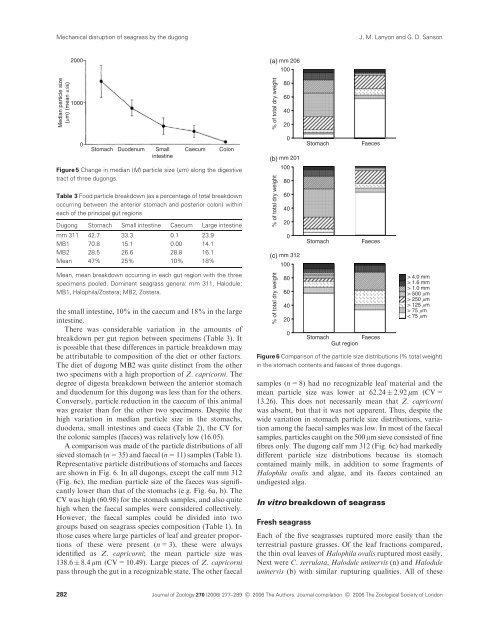

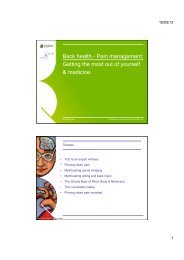
![Recycling [ PDF, 62KB ] - University of Queensland](https://img.yumpu.com/51805185/1/184x260/recycling-pdf-62kb-university-of-queensland.jpg?quality=85)
